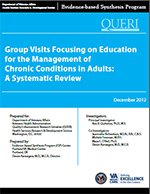
|
Principal Investigator: Ana R. Quiñones, Ph.D., M.S. Evidence-based Synthesis Program (ESP) Center
Portland VA Medical Center
Washington (DC): Department of Veterans Affairs; December 2012 |
Download PDF: Complete Report, Executive Summary, Report, Appendices
The goal of group-based educational programs led by non-prescribing facilitators is to communicate information and provide training in order to improve self-management skills for the large numbers of patients coping with chronic illness. The Veterans Administration (VA) has prioritized group visit implementation as part a new primary care model that focuses on patient centeredness, the Patient Aligned Care Team (PACT), but the choice of which patient populations to target and which interventions to use is unclear. Though the group visit intervention delivery model has been widely used, there are vast differences in program structure, content, length of intervention, and follow-up time points. Moreover, there is little consensus as to whether, and for whom, group visits are an effective tool. Given the variety of interventions, the broad array of chronic conditions in which group visit interventions have been studied, and the lack of an overall understanding of effectiveness, it is useful to clarify what is known and not known about group visit interventions in patients with chronic illness. To our knowledge, no recent review has examined group visit interventions across a variety of conditions.
The objectives of this review are to: 1) summarize the characteristics of group visit interventions that have been tested in controlled trials of patients with chronic illness; 2) assess the effects of these interventions on quality of life, self-efficacy, health care utilization, and other health outcomes; 3) understand whether there are certain patient characteristics associated with intervention effectiveness; and 4) examine which components of group visit intervention structure and delivery may be associated with intervention effects.